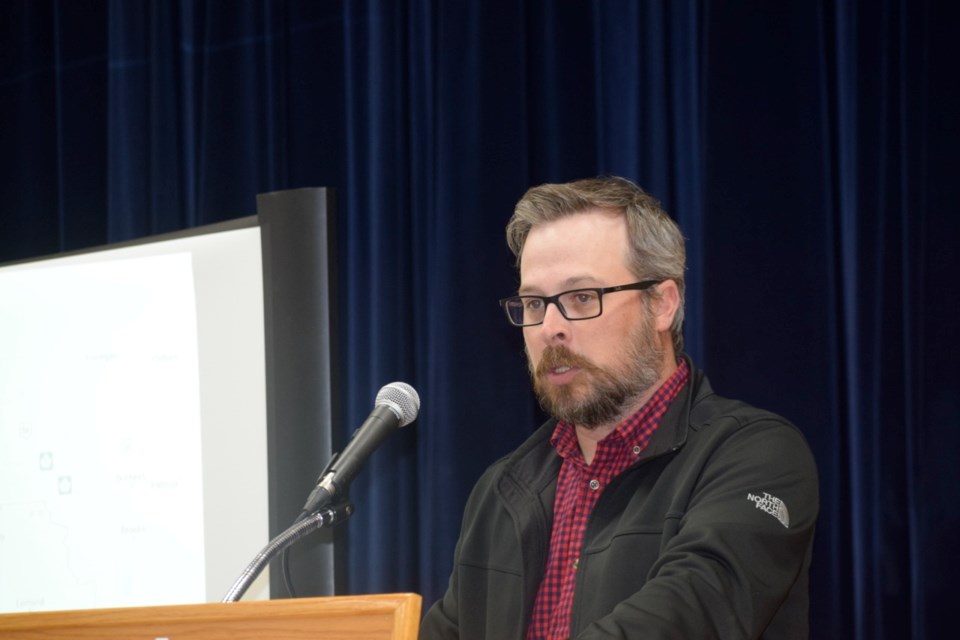ESTEVAN — Ratepayers from the RM of Estevan were supplied with lots of information about renewable energy during a session on April 26 at the Royal Canadian Legion’s Estevan branch.
Jason Schneider, who is the reeve for Vulcan County in Alberta, discussed how projects like wind and solar have impacted the area. Also, Brian Zinchuk, the owner and editor of Pipeline Online, shared numbers about the reliability of wind and solar in Alberta.
James Trobert, who is the councillor for the RM of Estevan’s Subdivision 5, said they extended an invitation to ratepayers in the RM and other neighbouring rural municipalities. Trobert noted there are some “drastic changes” that are about to occur in southeast Saskatchewan, with the closure of coal-fired power plants and green-energy initiatives touted to replace them.
Schneider, who operates a family farm near Vulcan, said the county was one of the first in southern Alberta to have these projects proposed in 2011.
“I’ve had a bit of a first-hand view of how these projects have impacted our municipality and some of the things we’ve seen, the good and the bad,” said Schneider.
He encouraged everyone to stay curious and ask questions, because this is a very different industry versus what they know with agriculture, and oil and gas.
A 300-megawatt, $600 million wind project was proposed over approximately 40 kilometres of land at the south end of the county in 2013.
“Ultimately this project actually went quite well. We had a developer that was really willing to work with residents as well as the council of the day,” said Schneider.
A 150-acre solar project, located south of the town of Vulcan and owned by an Indigenous community, also went well.
A 465-megawatt project, covering 3,300 acres, was built on land that Schneider said was used for grazing.
“It wasn’t as controversial as it could have been just because of the siting, and there was nobody really out there as well,” said Schneider.
Ten years ago, the developer wanted to move in and be part of the community, he said. They compensated landowners. There was a good working relationship and issues were resolved quickly.
“Most evolving industries, the first project is always the controversial one … you don’t know what’s going to happen.”
There weren’t any appeals and people spoke in support of the project. The industry has evolved quickly, he said, and issues have arisen that weren’t there 10 years ago. Projects are being proposed, but then it is sold to the next company, who sells it to the next company, and so on.
“Our wind project that is going on right now … hasn’t been received as well, and some of it is because it’s changed hands a couple of times,” said Schneider.
Before renewables, Schneider said 60 per cent of the county’s assessment was oil and gas and 40 per cent was agriculture. Now the windmills are 20 per cent and solar facilities are more than 30 per cent.
The projects create a lot of jobs during construction, and they will create some employment via maintenance once they’re finished.
Schneider also discussed reclamation and environmental impact with these projects. Because it’s a private developer on private land, it winds up in the landowner’s hands, which is something that has to be considered.
“Every one of these contracts is different. There really is no standard. And I think that’s something as a landowner as well as a municipality, you have to keep in mind is there is no standard contract here.”
He also urged landowners to get everything in writing with these big developments.
“If everybody just keeps asking, then eventually you hope you can get an answer, and you probably have a legitimate concern if nobody’s willing to answer the question.”
People want to know how this affects land values. It’s admittedly hard to quantify, he said. Prices have gone up in the county, but other issues are at play too.
As for wildlife and environmental concerns, they haven’t had a big issue with bird strikes and the windmills.
Zinchuk said Saskatchewan is on the path Alberta has been on for a decade.
He noted there is a website, the Alberta Electric System Operator, which provides minute-by-minute data on every single generating unit in the province.
It offers a look at performance on coal, wind, solar and other sources. He noted that on Jan. 1, 2022, when Alberta had 2,700 megawatts of wind and 600-700 megawatts of solar available, there were three megawatts of wind power generated on a night when an extreme cold warning was issued. And since it was night, solar produced nothing.
“Here’s the fundamental thing. It’s not when things work that’s the problem. It’s when things don’t work.”
It’s a trend that he has seen repeated numerous times.
Since then, SaskPower has started to show similar information, but it is delayed by a day, and it is averaged over 24 hours.
A question-and-answer session followed with the speakers and the 50 people in attendance.


